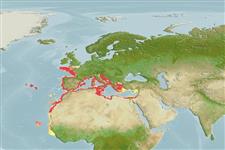Common names from other countries
Environment: milieu / climate zone / depth range / distribution range
Écologie
; profondeur 0 - 200 m (Ref. 2754). Subtropical, preferred 19°C (Ref. 107945); 50°N - 9°N, 32°W - 36°E (Ref. 99669)
Eastern Atlantic and the Mediterranean: North to the Channel Islands, south to Guinea, including Azores, Canary and Cape Verde Islands, and east to the Mediterranean. Introduced in Ireland and Gulf of Aqaba, Red Sea in Israel.
Length at first maturity / Taille / Poids / Âge
Maturity: Lm 4.9, range 4 - 5.4 cm Max length : 12.3 cm SHL mâle / non sexé; (Ref. 99669); common length : 8.0 cm SHL mâle / non sexé; (Ref. 438); âge max. reporté: 15 années (Ref. 99669)
Collected from the sublittoral zone, from low tide up to a depth of 200 m (Ref. 2754). Offshore (Ref. 438). Collected from the supralittoral and mediolittoral or intertidal zones (Ref. 2754).
Life cycle and mating behavior
Maturité | Reproduction | Frai | Œufs | Fécondité | Larves
Gonochoric; broadcast spawners (males release first before the females). Spawning occurs from spring to late autumn.
Demir, M. 2003. (Ref. 2754)
Statut dans la liste rouge de l'IUCN (Ref. 130435)
statut CITES (Ref. 108899)
Not Evaluated
Not Evaluated
Utilisations par l'homme
Pêcheries: commercial
FAO - Aquaculture: production; pêcheries: landings | FishSource | Sea Around Us
Outils
Sources Internet
Estimates based on models
Preferred temperature
(Ref.
115969): 7 - 18.6, mean 10.5 (based on 572 cells).
Résilience
Haut, temps minimum de doublement de population inférieur à 15 mois (K=0.27-0.4; tm=3; tmax=15).
